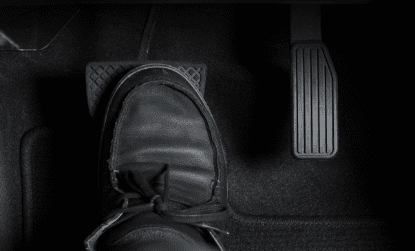Are you doing the right things when it comes to braking? If you’re a new driver, be sure to master the art of braking as soon as possible to ensure your safety on the road as well as a longer life for your vehicle’s braking system.
Here are the 8 tips that will help you brake smoothly and safely:
1. Refrain from using your brakes . . . when you don’t have to.
You can slow your car down without using your brakes. Instead, you can use your engine—which helps to minimize wear and tear on your brakes. This is how your engine works to help you brake: When you release your accelerator pedal, the decelerating forces of the heavy components moving inside your engine put a drag on the drive system. This means that as long as your vehicle is in gear, you will automatically slow down. For those driving with a manual transmission, slowing down with the clutch and engine is a regular part of driving a “stick.”
Braking using your engine can also help you control your speed when you are driving downhill if you shift to a lower gear. Just keep in mind that the technique will not work if you put your car in neutral.
Another way to avoid unnecessarily using your brakes is by maintaining a safe driving distance of about three seconds from the vehicle in front of you.
2. Maintain a high level of situational awareness.
Situational awareness, simply put, is being aware of where you are, where you are supposed to be, and what is going on around you. It applies to a broad range of situations—from air traffic control to driving a vehicle, from law enforcement to even the seemingly uneventful act of walking around your neighborhood.
So to brake smoothly, you need enough time to recognize that you need to brake and perform the act of braking. Look far ahead to see anything that would require you to slow down or stop—whether it’s a sign or signal, a road marking, pedestrians or animals crossing the road, other vehicles, or potential hazards like huge potholes, temporary road blocks, etc.
3. Brake smoothly and on time.
When it comes to driving, coming to a smooth and complete stop within a split second is not possible. This is why you see the Stop Ahead sign first before the actual Stop sign. Depending on the conditions on the road, you may step on the brakes 20 feet or more as you’re still approaching a Stop sign.
4. Step on the brake pedal until you feel pressure.
Make sure it’s one fluid movement. To stop, put your foot on the pedal and gradually increase pressure until you come to a smooth, complete stop.
5. Mind the position of your feet.
Your feet should be in the right position. Your right foot should be in line with the right half of the brake pedal with your heel on the floor. Your left foot should be on the firewall for balance and support.
6. Cover the brake when there’s potential danger.
When you see a potential hazard, take your foot off the accelerator and place it over the brake. Doing this reduces the likelihood of a crash since coming off the accelerator reduces your speed and your reaction time. A shorter reaction time means a shorter stopping distance—that is, you can stop well before you hit any pedestrians, another vehicle, or any other obstacle.
7. Opt for a gentler approach when turning.
When you navigate turns, your car will have a natural tendency to roll to the outside of the turn. This tendency is greater if you have a higher center of gravity, which is the common case with SUVs. This tendency worsens if you brake hard into a curve.
To turn around corners without braking hard, brake before you have to make the turn and then slowly accelerate through the curve.
8. Refrain from slamming on the brakes.
When you slam on the brakes, you cause unnecessary stress on your brake system components, rotors, pads, and brake calipers. That unnecessary stress is also felt by your passengers and the motorists sharing the road with you. Slamming on your brakes causes you to lose control of your vehicle and uneven wear on your tires.
However, sudden brakes are not entirely unavoidable, for reasons out of your control. For example, a pedestrian suddenly walking in front of you would require you to slam on your brakes.
Since modern cars have anti-lock brake systems (ABS), you no longer have to deal with the threat of your car skidding and loss of steering control when you lock up your wheels during an emergency stop or when you’re driving on wet roads.
However, you have to use the brake pedal properly (see #4) for your car’s ABS to work properly.
Avoid unnecessary braking, which leads to uneven wear and tear on your tires. Staying alert and being patient when you’re behind the wheel can go a long way in extending the life of your brake system, your tires, and your car.
If you’re looking for great savings when it comes to necessary repairs for your car, some of our products may just suit your needs. Check them out today, especially if your manufacturer’s warranty is running out soon.

